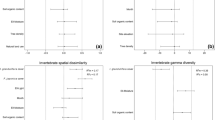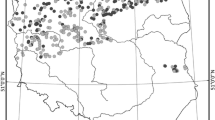Abstract
Biological plant invasions pose a serious threat to native biodiversity and have received much attention, especially in terrestrial habitats. In freshwater ecosystems impacts of invasive plant species are less studied. We hypothesized an impact on organisms from the water column and from the sediment. We then assessed the impact of three aquatic invasive species on the plants and macroinvertebrates: Hydrocotyle ranunculoides, Ludwigia grandiflora and Myriophyllum aquaticum. Our research on 32 ponds in Belgium indicated that the reduction in the native plant species richness was a common pattern to invasion. However, the magnitude of impacts were species specific. A strong negative relationship to invasive species cover was found, with submerged vegetation the most vulnerable to the invasion. Invertebrate richness, diversity and abundance were measured in sediments of invaded and uninvaded ponds along a gradient of H. ranunculoides, L. grandiflora, and M. aquaticum species cover. We found a strong negative relationship between invasive species cover and invertebrate abundance, probably due to unsuitable conditions of the detritus for invertebrate colonization. Taxonomic compositions of aquatic invertebrate assemblages in invaded ponds differed from uninvaded ponds. Sensitive benthos, such as mayflies were completely absent in invaded ponds. The introduction of H. ranunculoides, L. grandiflora, and M. aquaticum in Belgian ponds has caused significant ecological alterations in the aquatic vegetation and the detritus community of ponds.




Similar content being viewed by others
References
Ali MM, Soltan MA (2006) Expansion of Myriophyllum spicatum (Eurasian water milfoil) into Lake Nasser, Egypt: invasive capacity and habitat stability. Aquat Bot 84:239–244
Alpert P (2006) The advantages and disadvantages of being introduced. Biol Invasions 8:1523–1534
Alpert P, Bone E, Holzapfel C (2000) Invasiveness, invisibility and the role of environmental stress in the spread of non-native plants. Perspect Plant Ecol 3:52–66
Batzer DP (1998) Trophic interactions among detritus, benthic midges, and predatory fish in a freshwater marsh. Ecology 79:1688–1698
Boylen CW, Eichler LW, Madsen JD (1999) Loss of native aquatic plant species in a community dominated by Eurasian watermilfoil. Hydrobiologia 415:207–211
Brendonck L, Maes J, Rommens W, Dekeza N, Nhiwatiwa T, Barson M, Callebaut V, Phiri C, Moreau K, Gratwicke B, Stevens M, Alyn N, Holsters E, Ollevier F, Marshall B (2003) The impact of water hyacinth (Eichhornia crassipes) in a eutrophic subtropical impoundment (Lake Chivero, Zimbabwe). II. Species diversity. Arch Hydrobiol 158:389–405
Cattaneo A, Galanti G, Gentinetta S, Romo S (1998) Epiphytic algae and macroinvertebrates on submerged and floating-leaved macrophytes in an Italian lake. Freshw Biol 39:725–740
Cushman JH, Gaffney KA (2010) Community-level consequences of invasion: impacts of exotic clonal plants on riparian vegetation. Biol Invasions 12:2765–2776
Dandelot S (2004) Les Ludwigia spp. invasives du Sud de la France: Historique, Biosystématique, Biologie et Ecologie. Dissertation, Université d’Aix-Marseille III, Marseille
Dandelot S, Verlaque R, Dutartre A, Cazaubon A (2005) Ecological, dynamic and taxonomic problems due to Ludwigia (Onagraceae) in France. Hydrobiologia 551:131–136
Dandelot S, Robles C, Pech N, Cazaubon A, Verlaque R (2008) Allelopathic potential of two invasive alien Ludwigia spp. Aquat Bot 88:311–316
De Backer S, Van Onsem S, Triest L (2010) Influence of submerged vegetation and fish abundance on water clarity in peri-urban eutrophic ponds. Hydrobiologia 656:255–267
de Groot M, Kleijn D, Jogan N (2007) Species groups occupying different trophic levels respond differently to the invasion of semi-natural vegetation by Solidago canadensis. Biol Conserv 136:612–617
Feldman RS (2001) Taxonomic and size structures of phytophilous macroinvertebrate communities in Vallisneria and Trappa beds of the Hudson River, New York. Hydrobiologia 452:233–245
Gassmann A, Cock MJW, Shaw R, Evans CR (2006) The potential for biological control of invasive alien aquatic weeds in Europe: a review. Hydrobiologia 570:217–222
Gerber E, Krebs C, Murrell C, Moretti M, Rocklin R, Schaffner U (2008) Exotic invasive knotweeds (Fallopia spp.) negatively affect native plant and invertebrate assemblages in European riparian habitats. Biol Conserv 141:646–654
Gooden B, French K, Turner P, Downey P (2009) Impact threshold for an alien plant invader. Lantana camara L., on native plant communities. Biol Conserv 142:2631–2641
Gopal B, Goel U (1993) Competition and allelopathy in aquatic plant communities. Bot Rev 59(3):155–210
Gurevitch J, Padilla DK (2004) Are invasive species a major cause of extinctions? Trends Ecol Evol 19:470–474
Hejda M, Pyšek P (2006) What is the impact of Impatiens glandulifera on species diversity of invaded riparian vegetation? Biol Conserv 132:143–152
Hejda M, Pyšek P, Jarošík V (2009) Impact of invasive plants on the species richness, diversity and composition of invaded communities. J Ecol 97:393–403
Herrera AM, Dudley TL (2003) Reduction of riparian arthropod abundance and diversity as a consequence of giant reed (Arundo donax) invasion. Biol Invasions 5:167–177
Hulme PE, Bremner ET (2006) Assessing the impact of Impatiens glandulifera on riparian habitats: partitioning diversity components following species removal. J Appl Ecol 43:43–50
Hussner A (2008) Ökologische und ökophysiologische Charakteristika aquatischer Neophyten in Nordrhein-Westfalen, Dissertation, Heinrich-Heine-Universität, Düsseldorf, Germany
Hussner A (2009) Growth and photosynthesis of four invasive aquatic plant species in Europe. Weed Res 49:506–515
Hussner A, Meyer C, Busch J (2009) The influence of water level and nutrient availability on growth and root system development of Myriophyllum aquaticum. Weed Res 49:73–80
Kent M, Coker P (1992) Vegetation description and analysis—a practical approach. Wiley, Chichester
Küster EC, Kühn I, Bruelheide H, Klotz S (2008) Trait interactions help explain plant invasion success in the German flora. J Ecol 96:860–868
Lambinon J, De Langhe J, Delvosalle L, Duvignaud J (1998) Flora van België, het Groothertogdom Luxemburg, Noord-Frankrijk en de aangrenzende gebieden (Pteridofyten en Spermatofyten). Nationale Plantentuin van België, Meise
Langdon SJ, Marrs RH, Hosie CA, Mcallister HA, Norris KM, Potter JA (2004) Crassula helmsii in U.K. ponds: effects on plant biodiversity and implications for newt conservation. Weed Technol 18:1349–1352
Mack RN (2003) Phylogenetic constraint, absent life forms, and preadapted alien plants: a prescription of biological invasions. Int J Plant Sci 164:S185–S196
Mandaville SM (2002) Benthic macroinvertebrates in freshwaters—taxa tolerance values, metrics, and protocols. Project H-1, Soil & Water Conservation Society of Metro Halifax. xviii, 48 p, Appendices A-B, 120 p
Milbau A, Stout JC (2008) Factors associated with alien plants transitioning from casual, to naturalized, to invasive. Conserv Biol 22:308–317
Newman JR, Dawson FH (1999) Ecology, distribution and chemical control of Hydrocotyle ranunculoides in the U.K. Hydrobiologia 415:295–298
Pillips EC (2008) Invertebrate colonization of native and invasive aquatic macrophytes in Presque Isle Bay, Lake Erie. J Freshw Ecol 23:451–458
Pot R (2002) Invasion and management of Floating Pennywort (Hydrocotyle ranunculoides L.f.) and some other alien species in the Netherlands. In: Proceedings of the 11th EWRS international symposium on aquatic weeds, 2–6 Sep 2002, Moliets et Maa, France
Pyšek P, Pyšek A (1995) Invasion by Heracleum mantegazzianum in different habitats in the Czech Republic. J Veg Sci 6:711–718
Pyšek P, Jarošík V, Pergl J, Randall R, Chytrý M, Kühn I, Tichý L, Danihelka J, Chrtek jun J, Sádlo J (2009) The global invasion success of Central European plants is related to distribution characteristics in their native range and species traits. Divers Distrib 15:891–903
Ricciardi A, Atkinson SK (2004) Distinctiveness magnifies the impact of biological invaders in aquatic ecosystems. Ecol Lett 7:781–784
Shea K, Chesson P (2002) Community ecology theory as a framework for biological invasions. Trends Ecol Evol 17:170–176
Sheppard AW, Shaw RH, Sforza R (2006) Top 20 environmental weeds for classical biological control in Europe: a review of opportunities, regulations and other barriers to adoption. Weed Res 46:93–117
Shupryt MP, Stelzer RS (2009) Macrophyte beds contribute disproportionally to benthic invertebrate abundance and biomass in a sand plains stream. Hydrobiologia 632:329–339
Sokal RR, Rohlf FJ (2003) Biometry: the principles and practice of statistics in biological research. W.H. Freeman and Company, Australia
Strayer DL, Malcom HM (2007) Submersed vegetation as habitat for invertebrates in the Hudson River Estuary. Estuaries Coasts 30:253–264
Strayer DL, Lutz C, Malcom HM, Munger K, Shaw WH (2003) Invertebrate communities associated with a native (Vallisneria americana) and an alien (Trappa natans) macrophyte in a large river. Freshw Biol 48:1938–1949
Sutherland S (2004) What makes a weed a weed: life history traits of native and exotic plants in the USA. Oecologia 141:24–39
Theel HJ, Dibble ED, Madsen JD (2008) Differential influence of a monotypic and diverse native aquatic plant bed on a macroinvertebrate assemblage; an experimental implication of exotic plant induced habitat. Hydrobiologia 600:77–87
Thiébaut G (2007) Invasion success of non-indigenous aquatic and semi-aquatic plants in their native and introduced ranges. A comparison between their invasiveness in North America and France. Biol Invasions 9:1–12
Thorp AG, Jones RC, Kelso DP (1997) A comparison of water-column macroinvertebrate communities in beds of differing submersed aquatic vegetation in the tidal freshwater Potomac River. Estuaries 20:86–95
Toft JD, Simenstad CA, Cordell JR, Grimaldo LF (2003) The effects of introduced water hyacinth on habitat structure, invertebrate assemblages, and fish diets. Estuaries 26:746–758
UNEP (1999) Planning and management of lakes and reservoirs: an integrated approach to eutrophication. Technical Publication Series 11, Shiga, Japan
Van den Berg MS, Coops H, Noordhuis R, van Schie J, Simons J (1997) Macroinvertebrate communities in relation to submerged vegetation in two Chara dominated lakes. Hydrobiologia 342/343:143–150
van Donk E, van de Bund WJ (2002) Impact of submerged macrophytes including charophytes on phyto- and zooplankton communities: allelopathy versus other mechanisms. Aquat Botany 72:261–274
Van Landuyt W, Vanhecke L, Hoste I (2006) Rode Lijst van de vaatplanten van Vlaanderen en het Brussels Hoofdstedelijk Gewest. In: Van Landuyt W (ed) Atlas van de Flora van Vlaanderen en het Brussels Gewest. Instituut voor Natuur- en Bosonderzoek en Nationale Plantentuin van België, Brussel
Vanparys V, Meerts P, Jacquemart A (2008) Plant-pollinator interactions: comparison between an invasive and a native congeneric species. Acta Oecol 34:361–369
Verlaque R, Aboucaya A, Fridlender A (2002) Invasive alien flora of France: ecology, life-forms and polyploidy. Bot Helv 112:121–136
Wilcove DS, Rothstein D, Dubow J, Phillips A, Losos E (1998) Quantifying threats to imperiled species in the United States. Bioscience 48:607–615
Acknowledgments
First, we like to thank the following persons for field assistance: Linde Besard, Joëlle De Weerdt and Nele Vanbekbergen. We also thank Bianca Veraart (province of Antwerp) and the nature managers (Natuurpunt) for providing the locations of invaded ponds within the nature reserves. The following landowners generously allowed us to conduct research on their property: M. Farvaque, S. Rogiers, F. and C. De Lathauwer-De Weirdt, W. Orban and J. Henderickx. We thank Jamie Scott for English correction of the manuscript, and the Editor and two anonymous referees for useful comments on the manuscript. This paper is part of the project ‘ALIEN IMPACT’ financed by the Belgian Science Policy, contract number SD/BD/01A and by the Vrije Universiteit Brussel (OZR 1946 BOF).
Author information
Authors and Affiliations
Corresponding author
Electronic supplementary material
Below is the link to the electronic supplementary material.
Rights and permissions
About this article
Cite this article
Stiers, I., Crohain, N., Josens, G. et al. Impact of three aquatic invasive species on native plants and macroinvertebrates in temperate ponds. Biol Invasions 13, 2715–2726 (2011). https://doi.org/10.1007/s10530-011-9942-9
Received:
Accepted:
Published:
Issue Date:
DOI: https://doi.org/10.1007/s10530-011-9942-9




